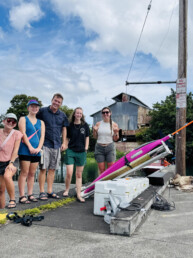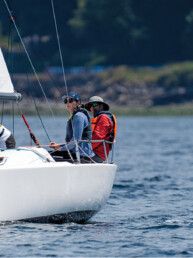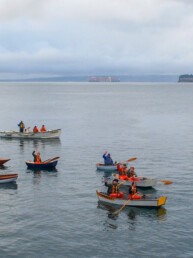Seasoned cruisers share their experiences pairing up with other sailors.
This article was originally published in the September 2021 issue of 48° North.
Smoke drifted upward from the grill on the stern, salads and side dishes adorned the cockpit table, the cupholders were full, and the sound of a cork popping from another bottle of wine was a welcoming one. Six adults chatted, laughed, and spun yarns of passages made and beautiful anchorages visited. All the while, kids of various ages scurried around on deck, some swung in a hammock, and others played a board game down below. Such is dinnertime for a group of buddy boaters.
This particular scene had a backdrop of majestic mountains in Alaska, yet it just as easily could have been a quiet anchorage in the San Juan Islands or a golden sandy beach with palm trees swaying at its fringes. In destinations all over the world, cruising boats finding comfort, camaraderie, and friendship amongst one another — it is a fact of life under sail. To many, it’s one of the most rewarding parts of the lifestyle.
But what are the realities of traveling with other boaters? The good, the not so good, and some tips for finding those friends? I enlisted fellow cruising pals Behan Gifford, Becca Guillote, Wendy Hinman, and Sarah Curry to provide some perspective and insight into one of the most common aspects of both local and long-distance cruising — buddy boating.
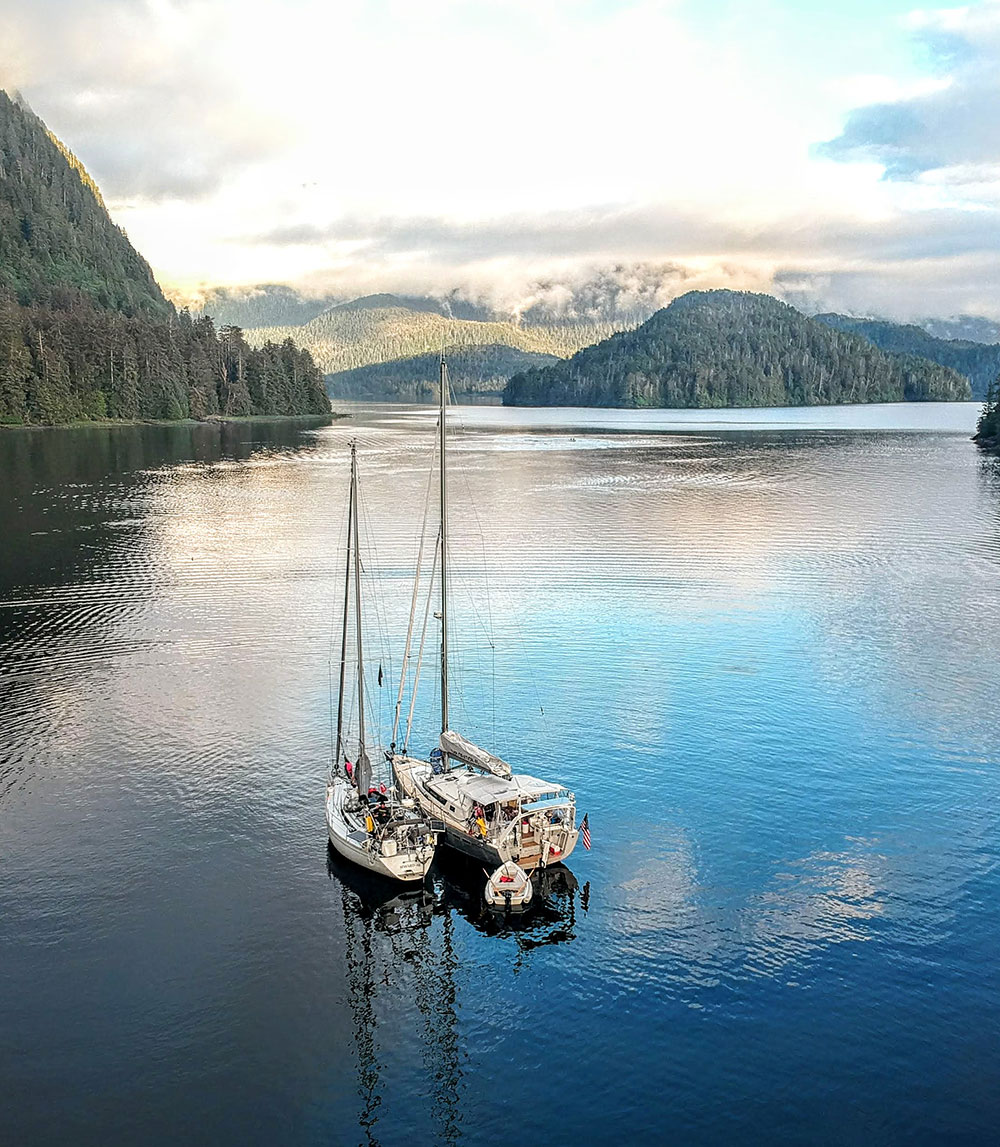
THE PROS
An unparalleled sense of camaraderie: Truly, the absolute best part of buddying up with another boat or three for an extended period of time is the close relationships you form. Every experienced cruiser I talked to brought up the idea of community and of friendships both fast and enduring as their favorite part of buddy boating. Becca Guillote summed up this notion of community very well:
“While every boat follows its own path, those paths perpetually intersect and merge, forming a fluid and dynamic community built on the strong undercurrents of acceptance, understanding, shared knowledge, and camaraderie. To meet other cruisers is to gain teammates — new friends watching your back and sharing their wisdom and their beers. There is little to no awkward get-to-know-you period. They are likely already friends with your friends; the introduction is simply a name-exchange that happens just before (or sometimes after) fixing a stubborn outboard together, discussing the next weather window, or sharing stories of passages, welders, recipes, and engine failures.”
This bond is so strong in part because, as cruisers, we’re away from our families and friends “back home” and are sharing a small space with only a partner — or partner and children. Our boat buddies fill that void. Wendy Hinman experienced this first-hand during her 7-year Pacific cruise with husband, Garth.
“Traveling with other cruisers provides incredible camaraderie when we are away from friends and family. Passages can feel solitary and reuniting with fellow sailors can give us something to anticipate. Also, fellow cruisers have a unique understanding of the unusual challenges we face with this lifestyle that friends and family back home don’t. Connecting and interacting with someone besides your crew mates can offer a pressure release valve that helps preserve your relationship — by offering an opportunity to spend time apart or engage in activities the other might not enjoy. And being in the company of others can help shift your thoughts away from personal worries.”
Personally, from the Pacific Northwest and on to Mexico and Central America, our family has found immense satisfaction in cruising with other families and couples of all ages. Some of our fondest memories are of watching the kids from Yahtzee and the Garcia Exploration 45 Arctic Monkey (our two boys and their three girls) bond through two years and many miles of cruising and living-aboard in Alaska. At times it seemed like we were one big traveling family moving from anchorage to anchorage and port to port.
It’s not just families that tend to find their way towards one another. We’ve enjoyed many close friendships with couples the age of our parents or grandparents. In one case, a couple we met in Mexico became like surrogate grandparents to our boys, having them over to play, listen to music, or make Christmas cookies so Jill and I could have some time for a happy hour alone or to work on boat projects.
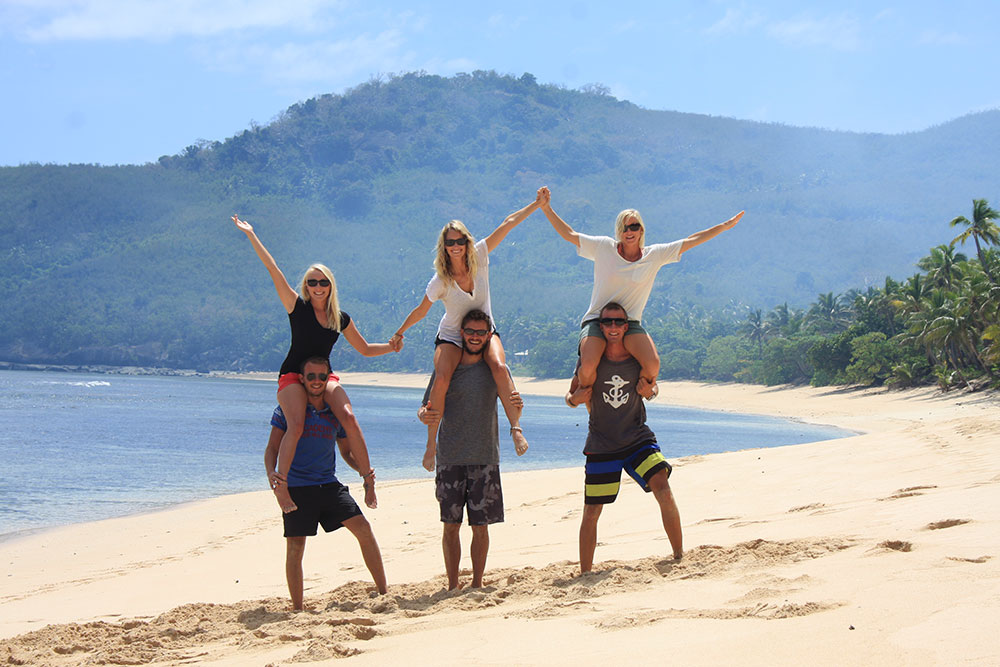
Buddies have things that you don’t: Another great part of buddying up with other boats is that you can share everything from information to boat parts as small as a screw, as well as ice or spare fuel. For Sarah Curry and her husband, Will, it was something a bit more involved than that:
“A close group of us (our Canadian boat and FOUR Swedish boats) arrived in the Kingdom of Tonga on a Sunday in late July. Being sleep deprived and hesitant to appear at customs on their day off, we decided to anchor away from the town of Neiafu for the night and delay our official check-in to Monday.
In our excited yet sluggish state, and without a careful investigative tour of the bay (there were much shallower sandy spots), Will and I dropped and set our Manson Supreme in 80-feet, the deepest water we’d ever anchored in. The next morning, our windlass absolutely could not budge the anchor; we were well and truly stuck and our not-so-legal presence in the country was a bit of a concern.
Our buddy boats had arrived and anchored close by, and Ola and Nina were already out for a morning swim. We waved them over, and Ola free dove the 80-feet(!) and surfaced with not-so-good news: ‘Your anchor is wrapped around a giant coral head, part of which has fallen on top of the chain.’
Not ideal. We radioed another buddy boat and Johannes soon paddled over, still half asleep, to perform a few underwater Swedish Scuba Superhero moves to free our anchor and chain. Some say the best buddy boats are those with an ice machine. I say — scuba gear!”
A team approach and safety net: Having a boat or two along with you on short or long passages helps because you can stay in touch and are rarely very far apart on the ocean if something were to go wrong. Lots of cruisers, especially those in foreign countries, point to buddy boating as a way to feel safe. While piracy is very rare, just having a single other boat around in an unfamiliar country can be comforting in a tenuous situation.
Sharing knowledge: Certainly one of the best parts of cruising with other boaters is that we share what we know. Cruisers have varying levels of knowledge and experience; no one person can really know it all. Sharing advice and help on weather routing, diesel or outboard engine troubleshooting, electronics, sail repair, watermaker servicing, and any number of other onboard tasks can be a huge plus.
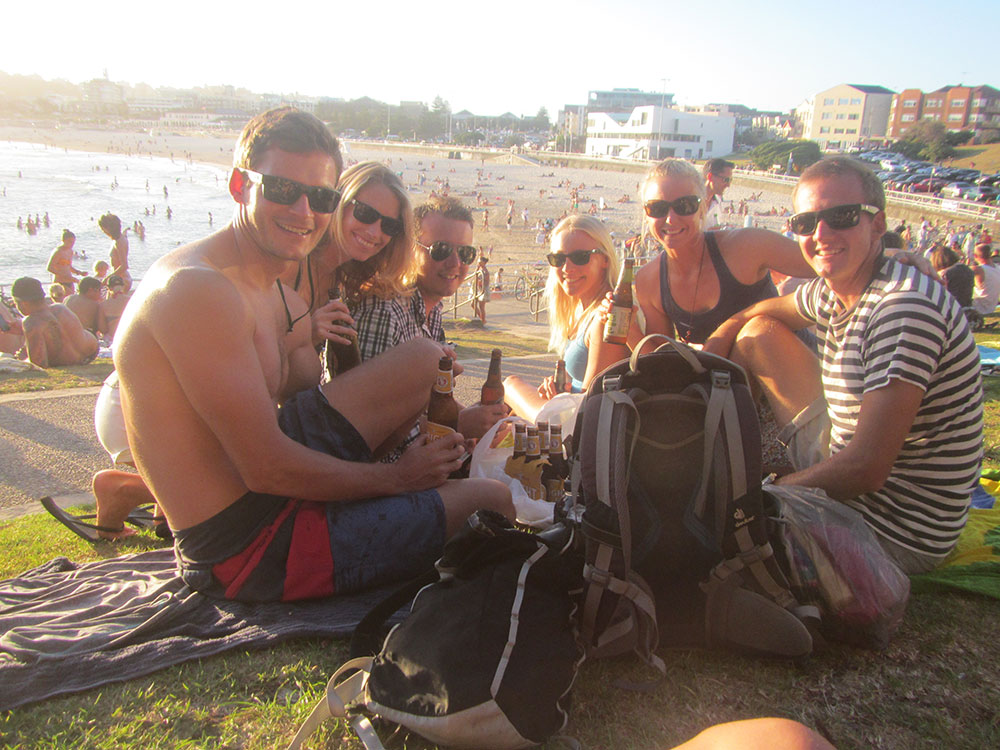
THE CONS
While many aspects of buddy boating might sound idyllic and perfectly suited to every cruiser, the honest truth is that it’s not always the case. Cruising can be hard at times, and adding more and more boats to the mix can increase the difficulty of everyone getting along. Also, as with life on land, you simply can’t be best friends with everybody. Some adults mesh better together than others do. The same goes with cruising kids. While children and teens on boats are known for being resilient, confident, active, and curious, that doesn’t always lead to an instant and tight connection.
Priorities, plans, personalities, and lifestyles can be just as dissimilar on the water as they are ashore, and when they clash, the options are to choose not to engage or pick up your anchor and move. Yet it bears repeating — for our family and others in this article, the quality and speed of connections between cruisers have been overwhelmingly strong and positive compared to our experiences ashore. Often, a byproduct of these tight bonds is that it can be difficult to break free when the time comes to say, “Fair winds.”
Becca aptly points out:
“You won’t always jive with everyone you meet, and that’s ok too because you likely won’t share a bay with them for very long. The hardest part is all of the goodbyes. The friendships develop so intensely and so quickly that separating after a single week can feel like saying goodbye to your childhood best friend. We always frame those moments as a ‘see you another time’ and never as a ‘goodbye forever’. Cruisers drift and wander, and it’s always possible to come together again somewhere at some time. I always hold that hope with the really close ones!”
Along with personal relationships, cruising as a group over long distances or for an extended period can cause strife as well. Sailing to a schedule can lead to buddy boating disaster, and even your individual cruising style matters.
Aboard Totem, Behan and Jamie Gifford have seen this firsthand:
“We’ve witnessed the difficulty of herd dynamics in decision-making. It may be hard to please everyone and can result in hurt feelings when priorities differ. Other times, the loudest voice steers. We watched in New Caledonia as the pressures on one boat led them to influence others into a timeline that probably didn’t suit their interests, but gave the loudest voice the company they wanted — which is not ideal.”
Wendy echoed these sentiments, but with a focus on how it can affect the engagement you might have had with others, such as locals in the area you’re visiting:
“Sometimes it is easy to travel in a pack and miss precious interactions with the native culture and intimate interactions with local people. Local residents may be less likely to interact with a group of boaters than with one or two.”
Another potentially negative aspect of buddy boating can be that you may not get the time alone as a couple or family that you anticipated or find necessary. For the crew on Yahtzee, coming from Alaska where we were mostly cruising solo or with one buddy boat, we always cherished our alone time. When we sailed south to places where there are many more cruising boats, we enjoyed the big group scene while also consciously working to break off with a small group or find some time to ourselves that we occasionally need. It’s all a balance.
This aspect of finding time for yourselves is something Wendy found essential, too:
“Traveling too closely with another boat may put pressure on your travel plans or you may discover you are less compatible than you previously thought. It may keep you from being open to meeting others or experiencing fully. And sometimes you need alone time to rejuvenate.”
BUDDY BOATING TIPS
Finding buddy boats is not always easy. A lack of cruising boats in a single area can be the biggest factor, but it can also draw a couple boats together. Conversely, sometimes when there are lots of boats it can feel hard to break into the “scene”.
We experienced the former first hand while circumnavigating Vancouver Island. Going counterclockwise around the island, we knew there weren’t many boats near us and they always seemed to be a day or two ahead or behind us. Finally, Yahtzee’s wake matched up with our friends Ryan and Autumn Helling on Velella (coincidentally Wendy and Garth’s former cruising boat), and we ended up spending two splendid weeks of buddy boating in Barkley Sound.
Cruising with friends you already have is one thing, but it can be entirely different to find new friends — especially if there are boats that already seemed to be buddied-up. Depending on your personality, the best thing to do is to introduce yourself and remain open-minded.
This meet-and-greet concept was key for Becca and her husband, John.
“My primary tip for finding buddy boats? Go talk to every boat in the anchorage! We would always jump on paddle boards in a new bay and paddle around the anchorage, chatting with the other cruisers. That may be easier for some who are outgoing than it is for others who are less so, but it’s good to remember that everyone out there is in the ‘same boat’. They are experiencing the same sunsets, same weather, same hardships (broadly speaking), and are also likely looking for community — you have much more in common than not.”
Similar to introducing yourself, Wendy has found that it may be the moments that you least expect when you find a new friend.
“Be open to meeting others whenever an opportunity presents itself. It might be at the dinghy dock, at a grocery store, at a gathering, on a street corner, or at a cultural event or even through a radio net. Introduce yourself and your boat name. Make and carry boat cards featuring your contact information and a picture of your crew and boat, so that you can share it whenever you make a connection.”
To keep those cherished buddy boating friends that you’ve made, Behan has the right idea:
“As in any relationship, communication is key! Nobody wants to be the remora, a moniker we heard used in the Bahamas to describe boats that latched on, unable to let go. Open discussion about intentions, and listening to each other, keep the air clear. Don’t be the remora! Buddy boating isn’t a substitute for self-reliance. Regardless of the skills of your friend or neighbor, most of the time you’re the one who will be fixing what’s broken.”
One final tip for those looking for buddies: to the extent that you’re able and up for it, start by being the inviter not the invitee. Wherever it is you strike up an enjoyable conversation with another cruiser, a terrific first step is to invite that cruiser (or couple or family) over for a casual round of sundowners, a dinner potluck on-board or ashore, or a hike the next day. If you’re up for this small dose of hosting, a lot of fun can follow quickly thereafter.
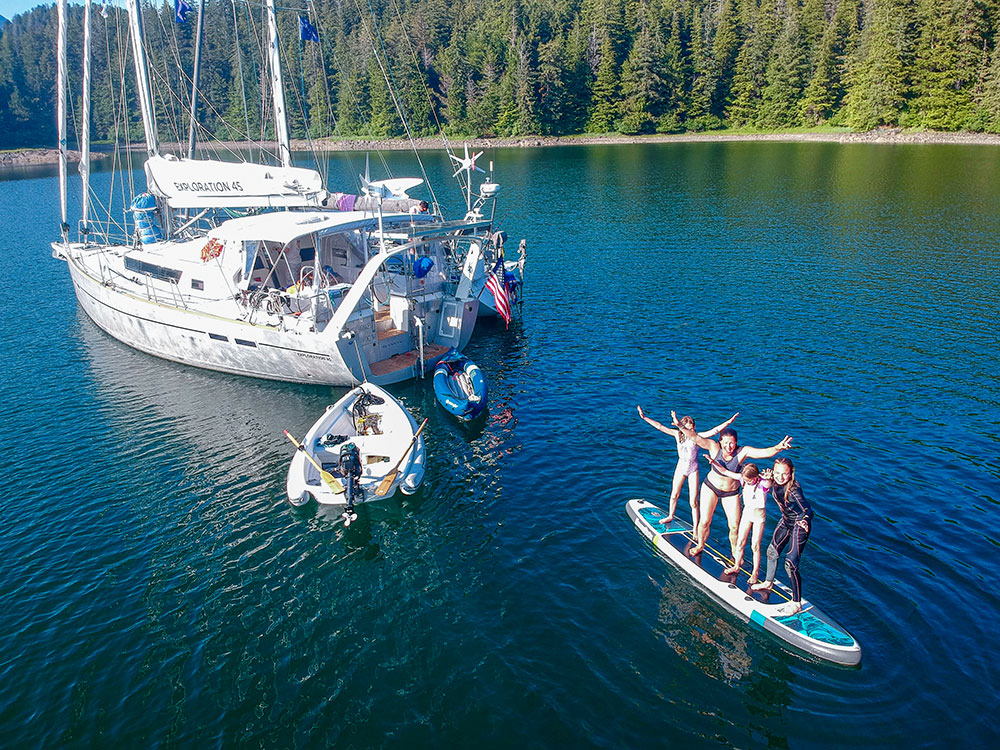
GO BE BUDDIES!
The best way to get into buddy boating locally is to find some like-minded cruisers that are already near you. They may have a boat down the dock from yours, or they could be a member of a boating club that you’re already a part of. From there, you’ll get the sense of the type of people you cruise well with, and those that you don’t. And if you don’t, it doesn’t have to be a big deal, you can pick a different destination with a different buddy.
It’s also important to recognize that buddy boating doesn’t have to be for long periods of time, across oceans, or hopping through foreign countries. You can share an anchorage for a night or weekend. Or take a few days of a week-long cruise through the San Juan or Gulf Islands and pair off with another boat to see how it works. If it works well, keep going.
Overall, buddying up with other boaters is an excellent way to make new friends, enjoy places with friends you already have, learn more about sailing and cruising, and have fun while doing it. Because, in the end, that’s what it’s all about — having fun. And when buddy boating is good, it’s really good.
Andy Cross is the editor of 48° North. You can follow his family’s cruising adventures at www.SailingYahtzee.com
Andy Cross
Andy Cross is the editor of 48° North. After years cruising the Pacific Northwest and Alaska with his family aboard their Grand Soleil 39, Yahtzee, they sailed south and are currently in the Caribbean Sea. You can follow their adventures at SailingYahtzee.com.


